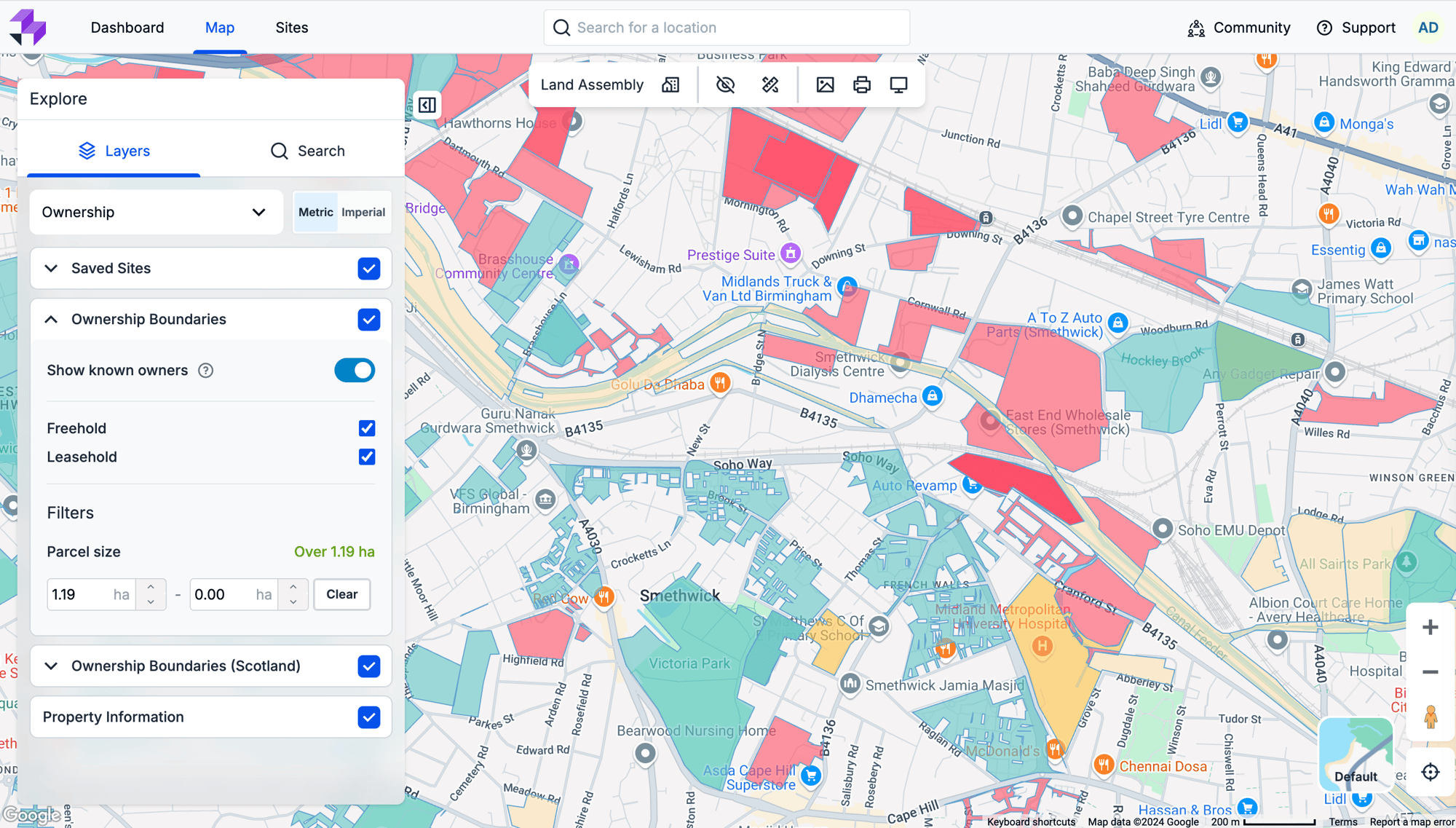When embarking on the process of identifying potential sites for development, having comprehensive ownership information at your fingertips is vital. This includes knowing whether a property is held by a freeholder or leaseholder, understanding the precise boundaries of the property, and identifying the ultimate owner.
These details aren’t just administrative though - they directly influence the viability of a development project and shape the negotiation strategies you might employ.
However, gathering this information presents considerable challenges. It can be a complex and time-consuming task, often requiring navigation through multiple sources and dealing with incomplete or outdated data - potentially slowing down your site selection process, and making it difficult to quickly assess and either act on or dismiss potential development opportunities.
But there is a much easier way to find what you need. You can access all the data you need on ownership in one single view within LandInsight. Below, we’ll take you through the Ownership data layer in LandInsight, a single view with all the information you need on ownership of properties, and how to maximise this layer, allowing you to focus on the opportunities that best match your development goals and objectives.
What is the Ownership layer?
At its core, the Ownership layer simplifies the often complex and time-consuming task of identifying land ownership. Rather than having to comb through HM Land Registry documents or Companies House to find what you need, the Ownership layer consolidates the information you need in one place.
You’ll be able to unlock comprehensive insights by seamlessly accessing ownership and contact details for sites where ownership information is publicly available, as well as the option to purchase title information on any other privately owned sites. Further, you can gather a high level snapshot of known owners in the area, including sites owned by companies, corporate bodies, local authorities, and housing associations and even filter by parcel size.
We've aggregated all the ownership data you need not only to easily accelerate the discovery process, but also ensure accuracy and reliability during site sourcing.

What data is in the Ownership layer?
Now that we have the basics of the Ownership layer covered, let’s take a deeper look at the data available in this layer, where the data comes from, and how often it's updated.
Ownership boundaries and types
To ensure you have the most accurate and up-to-date information to make informed decisions, LandInsight's Ownership data peels back the layers of the complexity of land ownership for England and Wales – presenting a clear map of ownership boundaries overlaying Google, Satellite, and OS Maps.
This view reveals the known property owners categorised as freeholders or leaseholders, and is drawn from HM Land Registry and Companies House. This information is updated monthly in LandInsight.
Parcel sizes
Within the Ownership layer, you can narrow down your search by filtering for parcel size and see the exact parcel boundary as well. This information is also retrieved from HM Land Registry and is refreshed on the 6th of every month within LandInsight, providing you with the most up-to-date information on a parcel’s size in case ownership boundaries have changed.
Ultimate owner information
Once you've identified a parcel of interest, quickly discover the property's ownership details, including whether it's held by a freeholder or leaseholder, the title owner, the last ownership change and more, by simply clicking on the parcel.
Detailed information, such as the ultimate owner and options to access the title register and plan, is readily available through a highlighted link. This comprehensive ownership data, sourced from HM Land Registry and Companies House and updated monthly, alongside addresses refreshed every 4-6 weeks from OS AddressBase Plus, is accessible directly from the platform's sidebar.
Best practices for maximising the Ownership layer
To fully harness the potential of the Ownership data layer, integration into the initial phases of your project planning is key. From filtering capabilities to match specific criteria to streamlining project management through the sites pipeline feature, using these features can help you stay abreast of new updates to continually refine your approach.
Filtering for precision
While understanding the ownership type of your potential opportunity is important, you may have additional criteria you need to filter for as well. Whether you’re looking for a certain parcel size, only want to see freeholders or are interested in specific ownership types, we’ve made filtering for precision easy.
You can filter for criteria in two ways:
- Filter in Ownership layer
Filter by parcel sizes and toggle between tenure types. These filters will then remove colour-coded parcels overlaid on the map to help you narrow down your search. - Site Sourcing Tool
Choose from a range of filtering options, including tenure, ownership type, and parcel size all in one go. These results will then appear in a list format, which you can download as a CSV and on the map in groups of properties.
Stay up to date with Ownership alerts
Another feature you’ll want to consider is Ownership alerts. Whether you’re scoping out your competition or looking to make a strategic long term play, you can set custom Ownership alerts to notify you of any ownership changes. These alerts will be emailed to you as soon as something changes, keeping you up to date with potential opportunities.
Managing your sites effectively
Once you’ve found the right sites using the filter or Site Sourcing feature, you’ll need to make sure you’re staying on top of your pipeline of opportunities. Across the entire platform, regardless of the data layer you’re using, you can easily save a site of interest with a few clicks using the Sites Pipeline.
Here’s our top 10 tips on getting the most out of your sites pipeline.
Ready to learn more?
Leveraging the Ownership layer’s data and best practices is just one of the important steps in the development process. By using the Ownership layer alongside LandInsight’s additional data sets, developers are equipped to swiftly pinpoint opportunities that align with their strategic goals, streamlining the path from site selection to project realisation.
With LandInsight, the once daunting task of understanding land ownership transforms into a strategic advantage, allowing developers to focus on what they do best: building the future.
Download our eBook, The Seven Building Blocks to Success: A Property Developer's Guide to LandInsight, now to take a deeper look at all the data available in LandInsight and how it can help you streamline your site sourcing.

